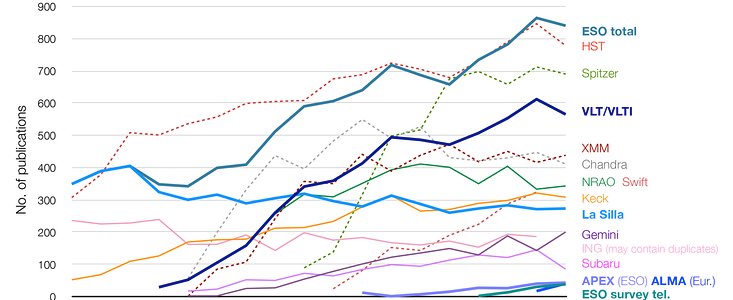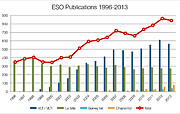Mitteilung
Die ESO bleibt das weltweit produktivste bodengebundene Observatorium
14. März 2014
Die Zahl der von Fachleuten referierten veröffentlichten wissenschaftlichen Publikationen im Jahr 2013, die Daten von ESO-Teleskopen und Instrumenten verwenden, hat gezeigt, dass die ESO das weltweit produktivste bodengebundene Observatorium geblieben ist. Astronomen haben im letzten Jahr Beobachtungsdaten von ESO-Einrichtungen für 840 begutachtete Publikationen verwendet. Die Zahl der Veröffentlichungen mit ESO-Daten blieb sogar etwas höher als die Zahl der Veröffentlichungen mit Beobachtungsdaten des NASA/ESA Hubble Space Telescopes.
In fast 70% aller Veröffentlichungen mit Bezug zur ESO im Jahr 2013 werden Daten verwendet, die mit dem Very Large Telescope (VLT) oder der VLT-Interferometer-Anlage erhalten wurden. Die produktivsten VLT-Instrumente für Publikationen bleiben FORS2 und UVES. Für X-Shooter zeigte sich außerdem ein steiler Anstieg der Zahl der Publikationen, wodurch sich in der Summe 170 Artikel in den Jahren 2010 bis 2013 ergeben.
Andere Einrichtungen am La Silla-Paranal-Observatorium – darunter das Durchmusterungsteleskop VISTA am Paranal sowie die La Silla-Teleskope und Instrumente – erlebten einen Anstieg im Vergleich zum vergangenen Jahr. HARPS bleibt das produktivste Instrument auf La Silla. Die Einrichtungen am La Silla-Observatorium haben Daten für mehr als 270 Publikationen geliefert, was alleine etwa der Zahl an Publikationen des nächstproduktiven bodengebundenen Observatoriums entspricht.
Für das Atacama Pathfinder Experiment (APEX), das von der ESO auf dem Chajnantor-Plateau in der chilenischen Atacamaregion betrieben wird – eine Zusammenarbeit des Max-Planck-Institutes für Radioastronomie (MPIfR, 50%), dem Weltraumobservatorium Onsala (OSO, 23%) und der ESO (27%) – wurde ein leichter Anstieg der ESO-Publikationen gegenüber dem vergangenen Jahr verzeichnet.
Das Atacama Large Millimeter/submillimeter Array (ALMA) hat am 13. März 2013 mit seiner offiziellen Einweihung den Übergang von der Bauprojektphase zu einem vollwertigen Observatorium gefeiert. Die begutachteten Publikationen mit ESO-Daten von ALMA haben sich seit 2012 verdoppelt, da die Ergebnisse der ersten wissenschaftlichen Testphase veröffentlicht werden [1].
Die Methoden zur Ermittlung dieser Zahlen variieren bei unterschiedlichen Observatorien, so dass die Grafiken nicht immer genau vergleichbar sind. Trotzdem hat die ESO jedes andere bodengebundene Observatorium signifikant übertroffen und liefert sich seit sechs Jahren ein Kopf-an-Kopf-Rennen mit dem NASA/ESO Hubble Space Telescope - Ergebnisse, die den Beitrag der ESO zu astronomischer Forschung deutlich festigen. Die veröffentlichten Statistiken geben einen Eindruck davon, wie viel wissenschaftliche Arbeit mit den Daten der unterschiedlichen Observatorien geleistet wird, zeigen aber nicht deren Auswirkungen auf die Wissenschaft.
Die Zahlen werden in der jährlichen Veröffentlichungsstatistik der ESO der ESO-Bibliothek mit der ESO-Teleskop-Bibliografie (telbib) berechnet und veröffentlicht. Hierbei handelt es sich um eine Datenbank, die alle begutachteten Publikationen enthält, für die ESO-Daten verwendet werden [2]. Die ESO unternimmt umfangreiche Bemühungen alle Publikationen mit ESO-Daten zu identifizieren und betrachtet telbib als im Wesentlichen vollständig.
Interaktive Grafiken ausgewählter Statistiken sind auch online verfügbar. Diese Grafiken zeigen den kompletten Inhalt der telbib-Datenbank für Publikationen vom Jahr 1996 bis heute. Sie können dazu genutzt werden, die Entwicklung wissenschaftlicher Veröffentlichungen, die Daten von ESO-Instrumenten verwenden, die Verwendung von Archivdaten und die durchschnittliche Anzahl an Autoren und ESO-Programmen pro Publikation zu untersuchen.
Endnoten
[1 Im Jahr 2013 wurden in insgesamt 65 Artikeln Daten von ALMA verwendet. Darunter waren jedoch 25, bei denen keine europäische Beobachtungszeit enthalten war, weshalb sie nicht in der Statistik berücksichtigt wurden. Analoges gilt für Artikel von anderen Teleskopen.
[2] Zu den Fachzeitschriften, die regelmäßig auf die Verwendung ESO-bezogener Schlüsselbegriffe überprüft werden, gehören: A&A, A&ARv, AJ, ApJ, ApJS, AN, ARA&A, EM&P, ExA, Icarus, MNRAS, Nature, NewA, NewAR, PASJ, PASP, P&SS and Science. Neue Einträge werden etwa drei Wochen, nachdem sie mit ihrem endgültigen Bibcode im NASA ADS Abstract-Service erschienen sind, hinzugefügt.
Links
Kontaktinformationen
Uta Grothkopf
ESO-Bibliothekarin
Garching bei München
Tel: +49 89 3200 6280
E-Mail: uta.grothkopf@eso.org
Lars Lindberg Christensen
Head of ESO ePOD
ESO ePOD, Garching
Tel: +49 89 3200 6761
Mobil: +49-173-3872-621
E-Mail: lars@eso.org
Über die Mitteilung
| ID: | ann14018 |
Our use of Cookies
We use cookies that are essential for accessing our websites and using our services. We also use cookies to analyse, measure and improve our websites’ performance, to enable content sharing via social media and to display media content hosted on third-party platforms.
ESO Cookies Policy
The European Organisation for Astronomical Research in the Southern Hemisphere (ESO) is the pre-eminent intergovernmental science and technology organisation in astronomy. It carries out an ambitious programme focused on the design, construction and operation of powerful ground-based observing facilities for astronomy.
This Cookies Policy is intended to provide clarity by outlining the cookies used on the ESO public websites, their functions, the options you have for controlling them, and the ways you can contact us for additional details.
What are cookies?
Cookies are small pieces of data stored on your device by websites you visit. They serve various purposes, such as remembering login credentials and preferences and enhance your browsing experience.
Categories of cookies we use
Essential cookies (always active): These cookies are strictly necessary for the proper functioning of our website. Without these cookies, the website cannot operate correctly, and certain services, such as logging in or accessing secure areas, may not be available; because they are essential for the website’s operation, they cannot be disabled.
Functional Cookies: These cookies enhance your browsing experience by enabling additional features and personalization, such as remembering your preferences and settings. While not strictly necessary for the website to function, they improve usability and convenience; these cookies are only placed if you provide your consent.
Analytics cookies: These cookies collect information about how visitors interact with our website, such as which pages are visited most often and how users navigate the site. This data helps us improve website performance, optimize content, and enhance the user experience; these cookies are only placed if you provide your consent. We use the following analytics cookies.
Matomo Cookies:
This website uses Matomo (formerly Piwik), an open source software which enables the statistical analysis of website visits. Matomo uses cookies (text files) which are saved on your computer and which allow us to analyze how you use our website. The website user information generated by the cookies will only be saved on the servers of our IT Department. We use this information to analyze www.eso.org visits and to prepare reports on website activities. These data will not be disclosed to third parties.
On behalf of ESO, Matomo will use this information for the purpose of evaluating your use of the website, compiling reports on website activity and providing other services relating to website activity and internet usage.
Matomo cookies settings:
Additional Third-party cookies on ESO websites: some of our pages display content from external providers, e.g. YouTube.
Such third-party services are outside of ESO control and may, at any time, change their terms of service, use of cookies, etc.
YouTube: Some videos on the ESO website are embedded from ESO’s official YouTube channel. We have enabled YouTube’s privacy-enhanced mode, meaning that no cookies are set unless the user actively clicks on the video to play it. Additionally, in this mode, YouTube does not store any personally identifiable cookie data for embedded video playbacks. For more details, please refer to YouTube’s embedding videos information page.
Cookies can also be classified based on the following elements.
Regarding the domain, there are:
- First-party cookies, set by the website you are currently visiting. They are stored by the same domain that you are browsing and are used to enhance your experience on that site;
- Third-party cookies, set by a domain other than the one you are currently visiting.
As for their duration, cookies can be:
- Browser-session cookies, which are deleted when the user closes the browser;
- Stored cookies, which stay on the user's device for a predetermined period of time.
How to manage cookies
Cookie settings: You can modify your cookie choices for the ESO webpages at any time by clicking on the link Cookie settings at the bottom of any page.
In your browser: If you wish to delete cookies or instruct your browser to delete or block cookies by default, please visit the help pages of your browser:
Please be aware that if you delete or decline cookies, certain functionalities of our website may be not be available and your browsing experience may be affected.
You can set most browsers to prevent any cookies being placed on your device, but you may then have to manually adjust some preferences every time you visit a site/page. And some services and functionalities may not work properly at all (e.g. profile logging-in, shop check out).
Updates to the ESO Cookies Policy
The ESO Cookies Policy may be subject to future updates, which will be made available on this page.
Additional information
For any queries related to cookies, please contact: pdprATesoDOTorg.
As ESO public webpages are managed by our Department of Communication, your questions will be dealt with the support of the said Department.


